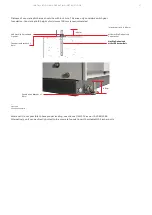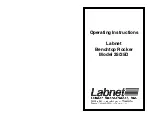
19
I N S TA L L AT I O N A N D O P ER AT I N G I N S T R U C T I O N S
—
7. Internal arc classification (IAC)
During development of all ABB products, focus is on
personnel safety. The SafeRing XT/SafePlus XT portfolio was
designed and tested to withstand a variety of internal arc
scenarios at the same current level as the maximum short
circuit current.
The tests show that the metal enclosure of
SafeRing XT/SafePlus XT is able to protect personnel
standing close to the switchgear during internal arc fault.
Causes and effects of internal arcs
Although an internal arc fault is highly unlikely it can
theoretically be caused by various factors, such as:
• Insulation defects due to quality deterioration of the
components. The reasons can be adverse environmental
conditions and a highly polluted atmosphere.
• Inadequate training of the personnel in chargeof the
installation leading to incorrect installation of the cables.
• Broken or modified safety interlocks.
• Overheating of the contact area, e.g. when the
connections are not sufficiently tightened.
• Short circuits caused by small animals that have entered
into the cable compartment (i.e. through cable entrance).
The energy produced by the internal arc causes the
follow- ing phenomena:
• Increase of the internal pressure.
• Increase of the temperature.
• Visual and acoustic effects.
• Mechanical stresses on the switchgear structure.
• Melting, decomposing and evaporation of materials.
Tested according to IEC standard 62271-200
The capability of SafeRing XT/SafePlus XT switchgear to
withstand internal arc is proven by type tests performed
according to internal arc classification (IAC) as described in
the standard IEC 62271-200 as follows:
Accessibility:
A and B (switchgear) A = Accessible to
authorized personnel only 300 mm safety distance on
accessible sides of the switchgear (also distance to sensors
during testing) B = public access 100 mm safety distance on
accessible sides of the switchgear (also distance to sensors
during testing)
Accessible sides of switchgear = Area that personnel can
enter freely. For accessibility A this means a 300 mm safety
di 500 mm or more in safe moving area.
Non-accessible side of switchgear = Area that is physically
blocked or clearly marked as not safe for personnel.
All test specimens passed the following test criteria
according to the standards:
1. Correctly secured doors and covers do not open
2. No fragmentation of the enclosure occurs within the
time specified for the test. Projection of small parts up
to an individual mass of 60 g are accepted
3. Arcing does not cause holes in the enclosure of the
switchgear up to a height of 2 m
4. Indicators do not ignite due to the effect of hot gases
5. The enclosure remains connected to its earthing point
—
Graph 7.1
Arc duration vs damage caused
R
L
F
L
F-Front = Access from the front
L-Lateral = Access from sides
R-Rear = Access from the rear
—
Figure 7.1
Access details for standard RMU
















































